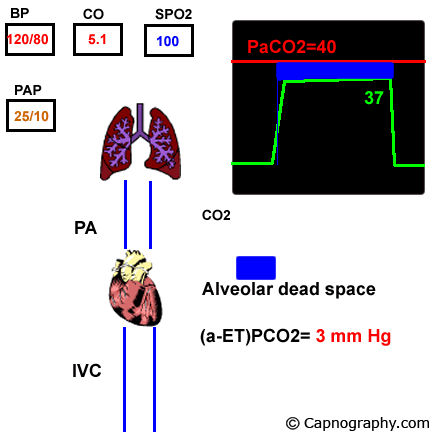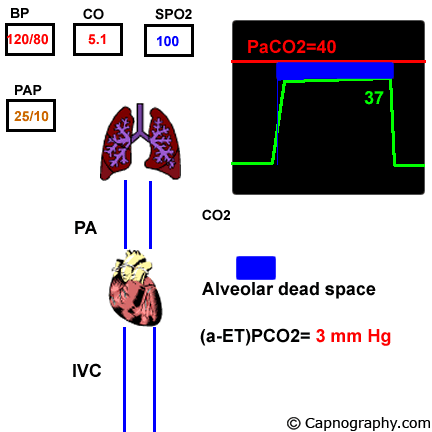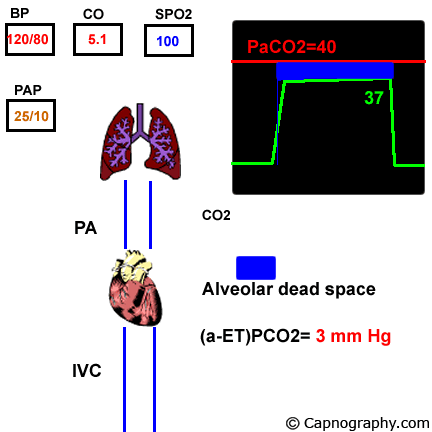Clinical Aspects
( I ) PETCO2 as an estimate of PaC02

PETCO2 may reflect PaCO2 at a new steady state level if (a-ET)CO2 is determined via ABG


In neonates with mild to moderate lung disease (FIO2 < 0.3 and respiratory frequency < 70/min), the distal sampling of CO2 measurements are preferred to proximal measurements as the former reflect PaCO2 more accurately than the later.12,13 However, in children with severe lung disease even the distal PETCO2 may not be good predictor of PaCO2 because (a-ET)PCO2 gradients varies with changing V/Q relationship of the sick neonate thus making PETCO2 measurements less reliable.14 Under these circumstances, PtcCO2 is more accurate estimate of PaCO2.13 The emphasis here is on more ABG’s until V/Q mismatch improves and a more constant (a-ET)PCO2 relationship is established.
In infants and children with acyanotic heart disease (left to right shunt), PETCO2 is closer to PaCO2 and (a-ET)PCO2 gradient is not significantly different from children with normal circulation.15,16 Further PETCO2 is a reliable estimate of PaCO2.16 However in children with cyanotic heart diseases, PETCO2 underestimates PaCO2 and the (a-ET)PCO2 gradient is increased up to 15 mmHg due a combination of venous admixture and low pulmonary perfusion.17 Under these circumstances, (a-ET)PCO2 is linearly correlated with arterial oxygen saturation (SPO2).17 With a decrease in SPO2 by 10% caused by right to left shunt, the (a-ET)PCO2 gradient can be expected to increase by 3 mm Hg.17
References
1. Nunn JF, Hill DW. Respiratory dead space and arterial to end-tidal CO2 tension difference in anesthetized man. J Appl Physiol 1960;15:383-9.
2. Fletcher R, Jonson B. Deadspace and the single breath test for carbon dioxide during anaesthesia and artificial ventilation. Br J Anaeasth 1984;56:109-19.
3. Shankar KB, Moseley H, Kumar Y, Vemula V. Arterial to end-tidal carbon dioxide tension difference during cesarean section anaesthesia. Anaesthesia 1986;41:698-702.
4. Askrog V. Changes in (a-A)CO2 difference and pulmonary artery pressure in anesthetized man. J Appl Physiol 1966;21:1299-1305.
5. Bhavani Shankar K, Moseley H, Kumar AY, Delph Y. Capnometry and Anaesthesia. Canadian J Anaesth 1992;39:6:617-32.
6. Leigh MD, Jones JC, Motley HL. The expired carbon dioxide as a continuous guide of the pulmonary and circulatory systems during anesthesia and surgery. J Thorac Cardiovasc Surg 1961;41:597-610.
7. Hoffbrand BI. The expiratory capnogram: a measure of ventilation-perfusion inequalities. Thorax 1966;21:518-23.
8. Tulou PP, Walsh PM. Measurement of alveolar carbon dioxide at maximal expiration as an estimate of arterial carbon dioxide tension in patients with airway obstruction. Am Rev Respir Dis 1970;102:921-6.
9. Rich GF, Sconzo JM. Continuous end-tidal CO2 sampling within the proximal endotracheal tube estimates arterial CO2 tension in infants. Can J Anaesth 1991;38:201-3.
10. Shankar KB, Moseley H, Kumar Y, Vemula V, Krishnan A. The arterial to end-tidal carbon dioxide tension difference during anesthesia for tubal ligation. Anaesthesia 1987;42.482-6.
11. Russell GB, Graybeal JM, Strout JC. Stability of arterial to end-tidal carbon dioxide gradients during postoperative cardiorespiratory support. Can J Anaesh 1990;37:560-6.
12 Kirpalani H, Kechagias S, Lerman J. Technical and clinical aspects of capnography in neonates. Journal of Medical Engineering and Technolology 1991;15:154-61.
13 Mcevady BAB, Mcleod ME, Mulera M, Kirpalani H, Lerman J. End-tidal, transcutaneous, and arterial PCO2 measurements in critically ill neonates. A comparitive study. Anesthesiology 1988;69:112-16.
14 Phan CQ, Tremper KK, Lee SE, Barker SJ. Noninvasive monitoring of carbon dioxide: A comparison of the partial pressure of transcutaneous and end-tidal carbon dioxide with the partial pressure of arterial carbon dioxide. J Clin Monit 1987;3:149-54.
15. Fletcher R. Relationship between alveolar deadspace and arterial oxygenation in children with congenital cardiac disease. Br J Anaesth 1989;62:168-76.
16, Fletcher R. Invasive and noninvasive measurement of the respiratory deadspace in anesthetized children with cardiac disease. Anesth Analg 1988;67:442-7.
17. Fletcher R. The relationship between the arterial and end-tidal PCO2 difference and hemoglobin saturation in patients with congenital heart disease. Anesthesiology 1991;75:210-6.

 Twitter
Twitter Youtube
Youtube









